Disclosure: We may earn commissions if you purchase products after clicking on a link from our site.
Are you interested in learning how to catch black sea bass? Do you want to catch black sea bass for some sumptuous dinners? Black sea bass is a favorite among anglers as it is not difficult to catch and it is a delicious fish. You can find it on the Atlantic Coast from Florida to Massachusetts.
In this article, we will discuss how to catch black sea bass, the fishing tackle, baits, and lures, as well as the best fishing rig setup for black sea bass.
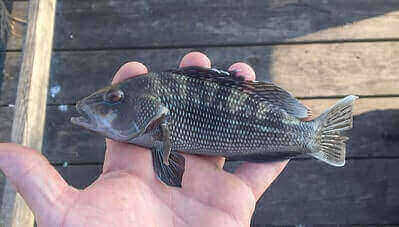
Table of Contents
How To Catch Black Sea Bass
Black sea bass are bottom feeders and are found at the bottom around reefs, wrecks, jetties, and rock pilings. At the bottom, they prey on clams, crabs, squid, mollusks, worms, and small baitfish. Black sea bass is not reluctant to take the bait and that makes it a favorite for anglers in addition to the fact that they are delicious.
1. Baitcasting
Baitcasting is a popular fishing method for targeting black sea bass, offering anglers precision and control when presenting bait or lures to these fish. Anglers typically use a baitcasting reel paired with a medium to heavy action rod, which provides the necessary strength to handle the often rocky and structured habitats where black sea bass are found.
When baitcasting for black sea bass, anglers can use a variety of bait rigs, such as bottom rigs baited with squid strips or cut bait. The key to success lies in accurately casting the baited rig to specific underwater structures where black sea bass congregate, such as reefs, wrecks, or rocky outcrops.
Anglers can then jig the bait up and down or let it sit on the bottom to entice strikes. It’s crucial to be mindful of local fishing regulations, including size limits and closed seasons, to ensure sustainable fishing practices.
2. Drift Fishing
Drift fishing is a popular and effective method for targeting black sea bass, especially when fishing over expansive areas of rocky bottom or underwater structures. Anglers employing this technique typically use a variety of bait rigs or lures, such as bucktail jigs or squid-tipped rigs.
The key to successful drift fishing for black sea bass lies in allowing the boat to drift naturally with the current while presenting bait or lures at varying depths. Anglers can adjust the weight of their rigs to ensure they reach the desired depth where black sea bass are feeding.
Additionally, using a fishfinder to locate underwater structures or areas of high fish activity can significantly improve the chances of success. When a strike occurs, anglers should quickly set the hook and carefully reel in the fish to avoid it tangling in the structure below. It’s essential to be aware of local fishing regulations and size limits to ensure responsible fishing practices.
3. Bottom Fishing
Bottom fishing is a tried-and-true method for targeting black sea bass, especially when fishing around rocky bottoms, wrecks, reefs, and other underwater structures where these fish congregate. Anglers employing this technique typically use bait rigs consisting of a sinker, leader, and hook baited with squid strips, cut bait, or other natural baits.
To catch black sea bass using bottom fishing, anglers drop their baited rigs to the ocean floor and allow them to settle near the structure where the fish are likely to be hiding. Once the bait reaches the desired depth, anglers can jig it up and down or let it sit stationary to entice strikes from black sea bass.
It’s essential to use a sensitive rod with medium to heavy action and a reel capable of handling the often strong and determined strikes of black sea bass. Anglers should also be mindful of local fishing regulations, including size limits and closed seasons, to ensure sustainable fishing practices.
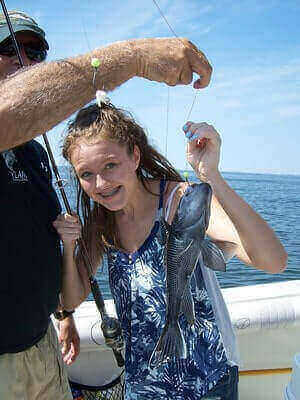
4. Trolling
Trolling can be an effective method for catching black sea bass, especially when targeting these fish over expansive areas or along underwater structures such as reefs and rocky bottoms. Anglers typically employ this technique by trailing baited lines or artificial lures behind a moving boat at varying speeds.
When trolling for black sea bass, anglers can use a variety of lures or bait rigs, such as diving plugs, spoons, or umbrella rigs rigged with squid or other natural baits. The key to successful trolling for black sea bass lies in covering a wide area to locate actively feeding fish.
Anglers should vary their trolling speed and depth to present their baits or lures at different levels of the water column where black sea bass may be present. Additionally, using a fishfinder to locate underwater structures or areas of high fish activity can significantly improve the chances of success. It’s essential to be mindful of local fishing regulations, including size limits and closed seasons, to ensure responsible fishing practices.
5. Rod and Reel Fishing
Rod and reel fishing is one of the most common methods used to catch black sea bass. Anglers typically use a medium to heavy action rod paired with a conventional or spinning reel loaded with braided or monofilament fishing line. Various bait rigs or lures can be employed, such as bottom rigs with squid or jigs tipped with bait.
Anglers can target black sea bass around rocky bottoms, wrecks, reefs, and other underwater structures where these fish congregate. By dropping baited rigs or jigs to the bottom and jigging them up and down, anglers can entice strikes from black sea bass.
It’s essential to adhere to local fishing regulations and size limits to ensure sustainable fishing practices. For more information on how to catch black sea bass using rod and reel fishing, anglers can consult resources provided by the National Oceanic and Atmospheric Administration (NOAA) at https://www.fisheries.noaa.gov/.
6. Spearfishing
Spearfishing is another method used to target black sea bass, particularly for those with underwater diving experience. This method involves free-diving or using scuba gear to approach black sea bass in their natural habitat and using a specialized spear gun or pole spear to catch them. Spearfishing requires patience, stealth, and precise aiming to successfully harvest black sea bass.
Anglers must ensure they comply with local fishing regulations and marine protected areas, as some areas may have restrictions on spearfishing.
7. Trap Fishing
Trap fishing, also known as pot fishing or crab pot fishing, can also be an effective method for catching black sea bass. Anglers deploy specialized traps or pots baited with fish or squid to attract black sea bass. The traps are set on the ocean floor and left for some time before being retrieved.
This method allows anglers to catch black sea bass in larger quantities and can be particularly effective in areas where these fish are abundant. However, it’s important to follow local regulations regarding trap fishing, including trap design, size limits, and placement restrictions.
Black Sea Bass Baits
- Squid
Squid is a highly effective bait for catching black sea bass, offering anglers a versatile option that appeals to these bottom-dwelling fish. Anglers can use fresh or frozen squid, cut into strips or whole, to attract black sea bass. To use squid as bait for black sea bass fishing, anglers typically rig the squid onto a hook, either alone or combined with other baits such as cut fish or crabs and present it near the bottom where these fish are commonly found.
Squid’s strong scent and natural movement in the water entice black sea bass to strike, making it a preferred bait choice for many anglers. It’s important to securely rig the squid onto the hook to withstand the fish’s strikes and avoid it being stripped off prematurely.
Additionally, anglers may choose to add scent attractants or brightly colored teasers to enhance the effectiveness of squid as bait. For more information on how to catch black sea bass using squid as bait, anglers can refer to educational resources provided by marine biology departments at universities such as the University of Florida (https://www.marinebiology.ufl.edu/).
2. Mollusks
Mollusks can be effective bait options for targeting black sea bass, offering anglers a natural and enticing option to lure these fish. Common mollusk baits include clams, mussels, and oysters, which can be used whole, chopped, or as strips to attract black sea bass. These baits emit scents and flavors that appeal to black sea bass, enticing them to strike.
To use mollusks as bait for black sea bass fishing, anglers typically rig them onto hooks or bait rigs and present them near the bottom where black sea bass are commonly found, especially around rocky bottoms, wrecks, and reefs. It’s essential to securely rig the mollusk onto the hook to withstand the fish’s strikes and ensure it remains on the hook during retrieval.
Additionally, anglers may choose to add scent attractants or brightly colored teasers to enhance the effectiveness of mollusks as bait. When using mollusks as bait, anglers should be mindful of local fishing regulations and size limits to ensure sustainable fishing practices.
3. Small Baitfish
Small baitfish are highly effective bait options for targeting black sea bass, providing anglers with a natural and enticing option to attract these predatory fish. Common small baitfish used for black sea bass fishing include minnows, anchovies, and sardines, which can be used whole or as cut bait to entice strikes.
These baitfish emit scents and vibrations that mimic natural prey, making them irresistible to black sea bass. To use small baitfish as bait for black sea bass fishing, anglers typically rig them onto hooks or bait rigs and present them near the bottom where black sea bass are commonly found, particularly around rocky bottoms, wrecks, and reefs.
It’s crucial to securely rig the baitfish onto the hook to withstand the fish’s strikes and ensure it remains on the hook during retrieval. Additionally, anglers may choose to add scent attractants or brightly colored teasers to enhance the effectiveness of small baitfish as bait. When using small baitfish as bait, anglers should be mindful of local fishing regulations and size limits to ensure sustainable fishing practices.
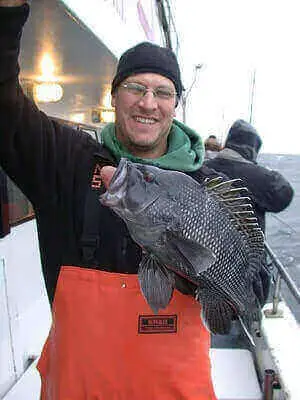
4. Clams
Clams are a popular and effective bait choice for black sea bass fishing, providing anglers with a natural and enticing option to attract these bottom-dwelling fish. Fresh or frozen clams, whether whole or chopped, emit a strong scent that appeals to black sea bass, enticing them to strike.
To use clams as bait for black sea bass fishing, anglers typically rig them onto hooks or bait rigs and present them near the bottom where these fish are commonly found, such as around rocky bottoms, wrecks, and reefs. It’s essential to securely rig the clam onto the hook to withstand the fish’s strikes and ensure it remains on the hook during retrieval.
Additionally, anglers may choose to add scent attractants or brightly colored teasers to enhance the effectiveness of clams as bait. When using clams as bait, anglers should be mindful of local fishing regulations and size limits to ensure sustainable fishing practices. Clams can be readily obtained from bait shops or harvested from coastal areas, providing anglers with a convenient and affordable bait option for targeting black sea bass.
5. Crabs
Crabs are highly effective bait for black sea bass fishing, offering anglers a natural and enticing option to attract these predatory fish. Common types of crabs used for black sea bass fishing include blue crabs, green crabs, and fiddler crabs, which can be used whole or as sections to entice strikes. These crustaceans emit scents and flavors that mimic natural prey, making them irresistible to black sea bass.
To use crabs as bait for black sea bass fishing, anglers typically rig them onto hooks or bait rigs and present them near the bottom where black sea bass are commonly found, particularly around rocky bottoms, wrecks, and reefs. It’s crucial to securely rig the crab onto the hook to withstand the fish’s strikes and ensure it remains on the hook during retrieval.
Additionally, anglers may choose to add scent attractants or brightly colored teasers to enhance the effectiveness of crabs as bait. When using crabs as bait, anglers should be mindful of local fishing regulations and size limits to ensure sustainable fishing practices. Crabs can be purchased from bait shops or harvested from coastal areas, providing anglers with a versatile and readily available bait option for targeting black sea bass.
6. Bloodworms
Bloodworms are a highly effective bait option for black sea bass fishing, renowned for their strong scent and attractive appearance to these bottom-dwelling predators. These segmented marine worms emit a potent scent that entices black sea bass, drawing them in from a distance. Bloodworms are typically rigged onto hooks or bait rigs and presented near the bottom where black sea bass are commonly found, such as around rocky bottoms, wrecks, and reefs.
Anglers can choose to thread bloodworms onto hooks individually or use them in combination with other baits to enhance their effectiveness. It’s essential to securely rig the bloodworm onto the hook to withstand the fish’s strikes and ensure it remains on the hook during retrieval.
Additionally, anglers may choose to add scent attractants or brightly colored teasers to further entice black sea bass. When using bloodworms as bait, anglers should be mindful of local fishing regulations and size limits to ensure sustainable fishing practices. Bloodworms can be purchased from bait shops or collected from coastal areas, providing anglers with a versatile and readily available bait option for targeting black sea bass.
7. Sandworms
Sandworms, also known as ragworms or lugworms, are highly effective bait for black sea bass fishing, valued for their natural scent and lifelike appearance. These marine worms are commonly found in sandy or muddy coastal areas and are prized by anglers for their ability to attract a variety of saltwater fish species, including black sea bass.
Sandworms emit a strong scent that entices black sea bass, drawing them in from a distance. Anglers typically rig sandworms onto hooks or bait rigs and present them near the bottom where black sea bass are commonly found, such as around rocky bottoms, wrecks, and reefs. It’s crucial to securely rig the sandworm onto the hook to withstand the fish’s strikes and ensure it remains on the hook during retrieval.
Additionally, anglers may choose to add scent attractants or brightly colored teasers to enhance the effectiveness of sandworms as bait. When using sandworms as bait, anglers should be mindful of local fishing regulations and size limits to ensure sustainable fishing practices. Sandworms can be purchased from bait shops or collected from coastal areas, providing anglers with a versatile and readily available bait option for targeting black sea bass.
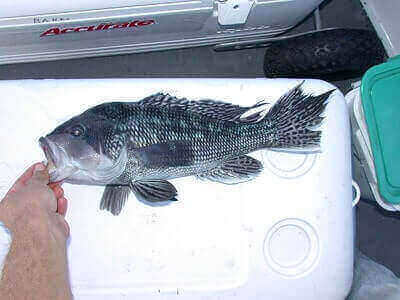
Best Lures For Black Sea Bass
- Jigs
Jigs are versatile and highly effective lures for black sea bass fishing, offering anglers a dynamic way to target these bottom-dwelling predators. Jigs come in various sizes, shapes, and colors, allowing anglers to match the hatch and mimic natural prey effectively.
Typically made of lead or other weighted materials, jigs are designed to sink quickly to the bottom, where black sea bass are commonly found, such as around rocky bottoms, wrecks, and reefs. Anglers can work jigs by bouncing them along the bottom or jigging them vertically to entice strikes from black sea bass.
The fluttering action and enticing movements of jigs mimic injured baitfish or crustaceans, making them irresistible to these predatory fish. Anglers often tip jigs with soft plastic baits or natural baits like squid or strips of baitfish to enhance their effectiveness.
When using jigs as lures for black sea bass fishing, anglers should experiment with different retrieval techniques, depths, and jig sizes to determine what the fish are actively feeding on. Additionally, anglers should be mindful of local fishing regulations and size limits when using jigs to ensure sustainable fishing practices. Jigs are readily available at tackle shops and online retailers, providing anglers with a versatile and reliable lure option for targeting black sea bass.
2. Spoons
Spoons are effective and versatile lures for black sea bass fishing, providing anglers with a straightforward yet highly effective method to entice strikes from these bottom-dwelling predators. These lures are typically made of metal and feature a concave, spoon-shaped design that creates a fluttering action as it sinks through the water column.
The reflective surfaces of spoons mimic the flash of baitfish, making them highly attractive to black sea bass and other predatory fish species. Anglers can cast spoons or jig them vertically, allowing them to cover a wide area of the water column where black sea bass are commonly found, such as around rocky bottoms, wrecks, and reefs.
The erratic movements and flashing action of spoons effectively mimic injured baitfish or fleeing prey, triggering aggressive strikes from black sea bass. Anglers can vary the speed of retrieval and impart subtle twitches or jerks to the spoon to further entice strikes. When using spoons as lures for black sea bass fishing, anglers should experiment with different sizes, colors, and retrieval techniques to determine what the fish are actively feeding on.
Additionally, anglers should be mindful of local fishing regulations and size limits when using spoons to ensure sustainable fishing practices. Spoons are readily available at tackle shops and online retailers, providing anglers with a reliable and effective lure option for targeting black sea bass.
Black Sea Bass Fishing Tackle
A 7 ft medium-weight rod and a reel with a 20 to 30-pound test line will work when learning how to catch black sea bass. This is just a general example of the fishing tackle that works for black sea bass fishing. Other anglers will have their preferred choice of tackle that works for the fishing methods they implement.
Black Sea Bass Rigs
The high-low rig is the most popular black sea bass rig. Use a 40-pound leader and cut a 30-inch piece with scissors. Then tie two dropper loops about 6 inches wide in the center of the leader. Create a sinker loop on one end of the leader by tying a Surgeons Loop Knot.
Then at the other end, tie the 75-pound barrel swivel using a clinch knot. Then attach the bank sinker by pinching the Surgeons Loop and thread it through the bank sinker hole. Then pull the loop over the entire sinker and cinch it tightly. The weight will then be secured on the rig.
However, you can change it without cutting or retying. Finally, attach the two hooks. Pinch the Drooper Loop, then thread it through the eye of the hook, then pull the loop over the hook, and cinch it tightly over the eye of the hook. You will then have completed the high-low rig.
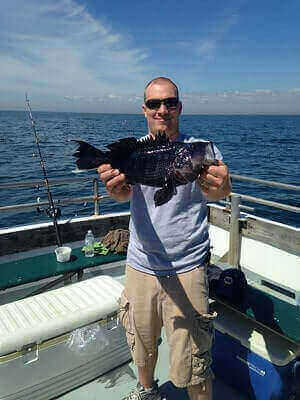
How To Catch Black Sea Bass From Shore
Black sea bass is usually found in deep water; however, in spring they migrate inshore to spawn in shallow waters. Look for jetties and areas with steep drop-offs. Baits like squid, clams, and seaworms can be used when fishing for black sea bass from the shore.
Black Sea Bass Fishing Tips
- Black sea bass is often found around structures like piers, jetties, shoals, reefs, rockpiles, and wrecks.
2. Black sea bass will fight hard when it is hooked.
3. Black sea bass can be found on the Atlantic Coast from Massachusetts to Florida.
4. Black sea bass move to shallow waters in spring to spawn. This represents a good opportunity for anglers to fish for black sea bass from the shore.

5. Black sea bass can be found all year round.
6. Black sea bass are bottom feeders and are often found close to the bottom around structures where they prey on squid, shrimps, crabs, baitfish, and other crustaceans.
7. Trolling, drift fishing, baitcasting, bottom fishing, and jigging are some of the fishing methods anglers use when fishing for black sea bass.
8. When bottom fishing, use the minimum amount of weight to get your bait or lure to the bottom.
9. If your bait bounces and moves a little at the bottom, that is just fine as it increases the effectiveness of the presentation.
The Bottom Line
Black sea bass is a bottom feeder that preys on crustaceans and other small baitfish. They are aggressive and fight hard when caught. Additionally, black sea bass are a favorite of anglers as they are delicious fish.
In this article, we discussed how to catch black sea bass, the fishing tackle, the fishing rig setup, as well as the baits and lures that are used to catch black sea bass. If you fish for white bass, spotted bass, smallmouth bass, and largemouth bass, you can read how to catch white bass, how to catch spotted bass, how to catch smallmouth bass, how to catch yellow bass, and how to catch largemouth bass.